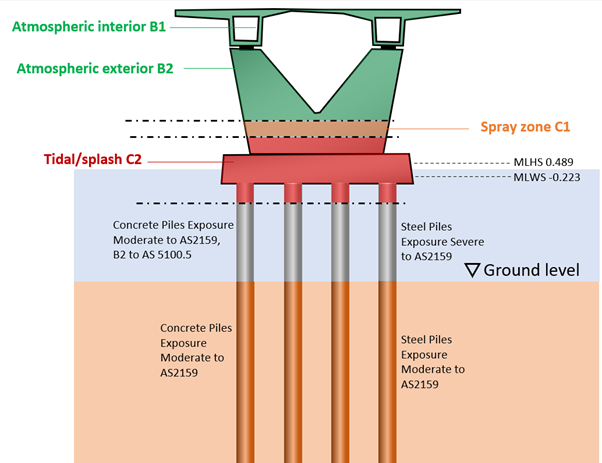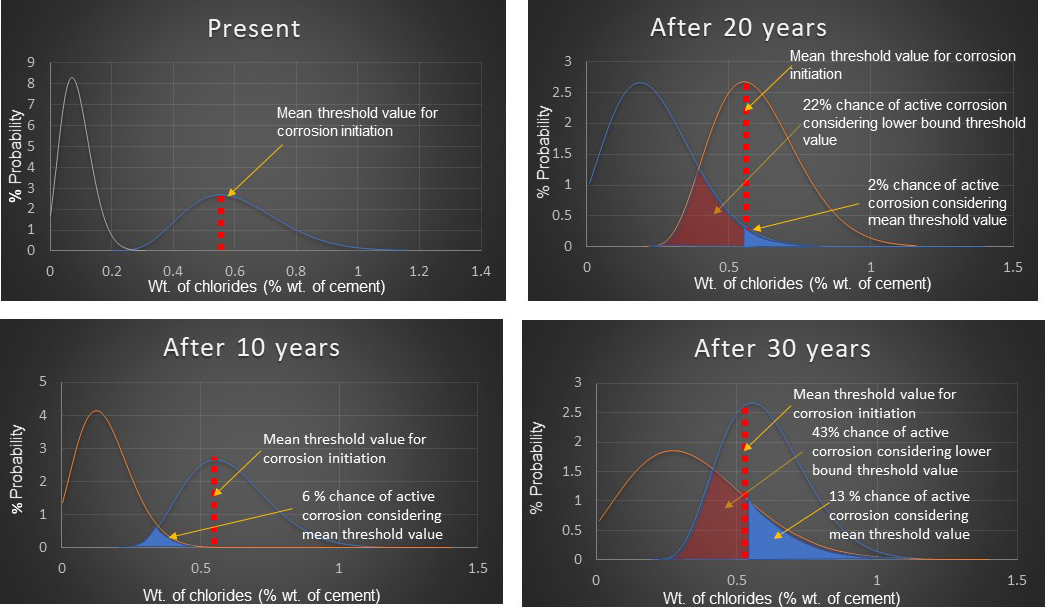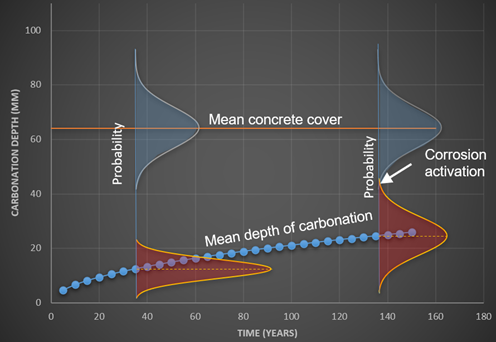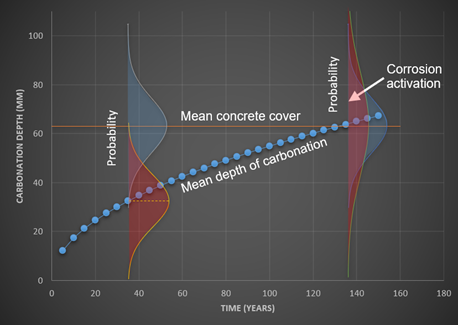BCRC conducts structural and durability surveys and provides world-leading remaining service life calculations using in-house and industry accepted models for both chloride ion and carbonation induced concrete reinforcement corrosion, to determine the remaining service life of the structural elements.
BCRC’s durability practice lead, Frank Papworth, is the Immediate past chair fib Commission 8 ‘Durability’ Convener fib TG8.10 ‘Steel Corrosion’. We have completed remaining service life assessments of structures including mines, railways, floors, buildings, wharfs, bridges, and tanks.
We have adopted fib’s reliability based design approach and have recently developed our in-house modelling protocol termed CREAD™ (Comprehensive Reliability and Engineering Analysis of Durability).
BCRC’s CREAD™ includes:
1) Appropriate liaison with clients to determine their service life requirements
2) Use of target reliabilities using a combination of a risk based approach, minimum life cycle cost and inclusion of propagation
3) Proper exposure assessment
4) Determination of appropriate critical chlorides
5) Appropriate use of penetrability
6) Full Probability Analysis
We will be using this state of the art protocol on this project to estimate the remaining service life of the affected elements and designing appropriate and optimised repair strategies for various elements of the structure.
At BCRC, the service life modelling comprises of the following tasks:
Evaluation of exposure conditions
BCRC has been involved in the evaluation of reinforced concrete structures at different exposure conditions. Concrete containing reinforcement or other embedded metal could be exposed to air and moisture with regard to different levels of temperature, humidity and oxidation, or be subject to contact with water containing chlorides, seawater or air carrying salt originating from seawater. We also provide remaining service life assessment of structures exposed to extreme conditions such as marine environment with alternating wetting–drying exposure to seawater, aggressive chemical environment, freeze–thaw attack as well as alkali-silica reaction, and specialise in solving magnesite floor topping issues of buildings.

Chloride ingress modelling
Chloride attack is one of the two main causes of corrosion of steel in concrete. Chloride ions from the environment can penetrate into the concrete and reach the reinforcement. If their concentration at the surface of the reinforcement reaches a critical level, the protective layer may be locally destroyed, in the presence of oxygen and water which could lead to corrosion of the reinforcement.
BCRC have strong technical expertise in determining the chloride depth profiles in the concrete, from which information on the transport of chlorides into the concrete, chloride diffusion rate and the further development of chloride-induced corrosion can be obtained. BCRC have developed chloride ingress modelling in-house models to determine the remaining service life of the structural elements.
Carbonation modelling
Carbonation is the other main causes of corrosion of steel in concrete. Carbonation of concrete is a complex physical and chemical process which can lead to loss of passivity of the reinforcement in the concrete. It may be affected by the variation of exposure conditions and concrete material properties.
BCRC have extensive experience on predicting carbonation rate of an existing structure. BCRC have developed carbonation modelling in-house models and analysis of statistical distribution of the carbonation depth and concrete cover thickness to estimate the amount of depassivated steel in reinforced concrete structures.
Corrosion propagation
Breakdown of the protective layer at the surface of reinforcement in concrete, such as the depasssivation process due to carbonation or chlorides, is the necessary prerequisite for the initiation of corrosion. Once this layer is destroyed, corrosion will occur on the surface of the reinforcement if water and oxygen are present. The corrosion rate, which varies considerably depending on temperature and humidity, can be used for predicting the time to concrete cracking and spalling.
BCRC can deliver high-quality corrosion propagation relevant investigation which includes but is not limited to half-cell potential survey and corrosion rate (linear polarization resistance) measurement with Corromap equipment, concrete resistivity measurement using Wenner probe.
Service life prediction under different scenarios
BCRC provides remaining service life modelling, based on the design limit state of reinforcement corrosion initiation, considered both loss of concrete alkalinity due to concrete carbonation and the ingress of chloride ions. Since widespread cover measurements enable relatively accurate assessments of the cover distribution, use with less extensive carbonation and chloride penetration data for the remaining service life modelling can be made. We could also provide empirical estimations of the time to reach any one of the several undesired events in the life of a structure such as severe loss of cross section of reinforcement, cracking of concrete cover, spalling and delamination of concrete cover.
BCRC CREAD™ Process
Define Service Required
- Design life
- Condition at end of design life
- Target reliability
- Maintenance allowance
Evaluate Exposure Classes
- Code based with DtS req.
- Code class ‘U’
- Exposure not in code
- Internal exposure (ASR; DEF)
Evaluate Materials Available
- Cementitious
- Aggregate
- Water
- Additives
Establish Critical Parameters
- Structural (e.g. robustness)
- Operational (reliability & exposure)
- Construction
Identify Deterioration Mechanisms
- Corrosion
- External chemical attack
- Internal chemical attack
- Physical attack
- Early age cracking (EAC)
Identify Construction Parameters
- Materials and production
- Delivery and placing
- Compaction and finishing
- Sealed and thermal curing
- Plastic crack susceptibility
Life Verification (ref fib MC 2020 LoA)
- Consider Code DtS req.
- Full probabilistic modelling (cl-, carb, chemical, prop.)
- Review avoidance measures
Construction Methods Verification
- Avoidance of defects
- Minimising non-conformance
- Suitable EAC control
- Plastic crack control
Specify Validation of Service Life
- Avoidance of defects
- Visual inspection
- Corrosion monitoring
- Use of ‘tell tales’ and sample
Key projects:
- Stadium Australia
- Hunter building and swimming pool, The University of Newcastle
- UNSW swimming pool
- Musswellbrook pool
- Crooked River bridge
- Springhill Road culvert
- Martin Place railway pedestrian underpass
- Cabbage Tree Island bridge
- Ropes Creek bridge
- Arcadia culvert
- Colongra power station heavy hauls bridge
- Japanese University (old Newcastle courthouse)
- Kissing point wharf
- Snails Bay Mooring Dolphins
- Garden island
- Bindaree beef abattoir
- Slab of old Newcastle hospital
- Edikan Gold mine
- FMG Port expansion outload circuit
- Lion ore plant
- Iluka acid bunker
- Paddington mine crusher
- Marquesas twin towers building
- Residential building at 276 Birrell Street, Bondi
- Penshurst tank
- Bankstown tank
- Adelaide desalination plant



